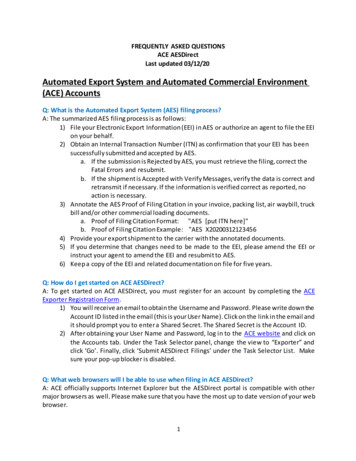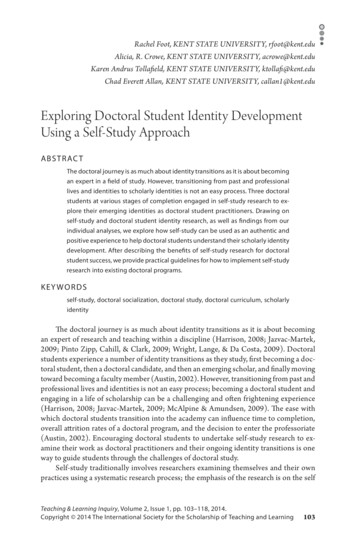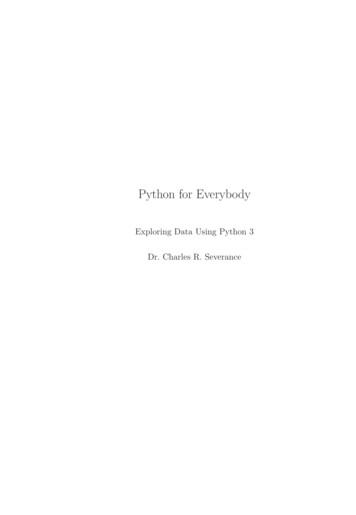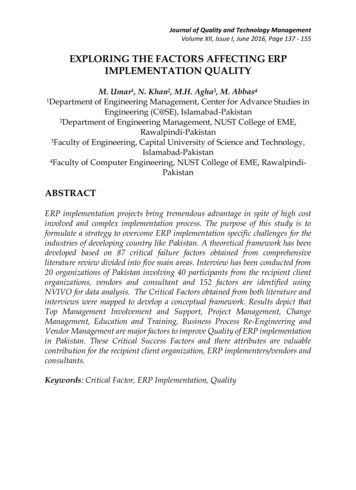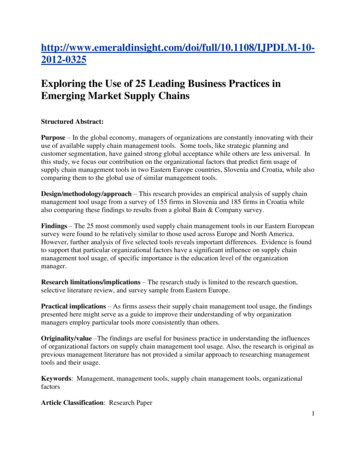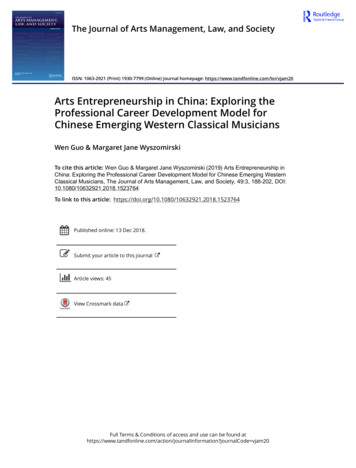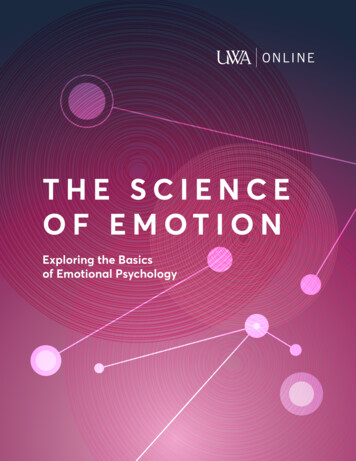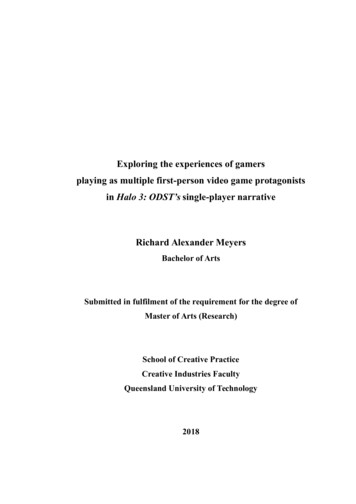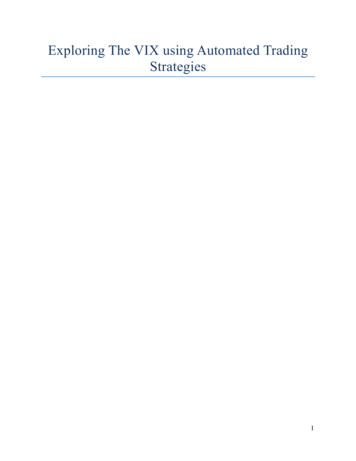
Transcription
Exploring The VIX using Automated TradingStrategies1
AbstractThis study consists of two major sections: a background analysis of stocks in the biotechand pharmaceutical industry, and the creation and evaluation of trading strategies. The firstsection investigates some technical aspects of historical stock data as well as their correlationwith investor sentiment. This section aims to answer how the Chicago Board OptionsExchange’s volatility index (VIX) can be used to predict stock movement. The second sectioncovers the creation and evaluation of trading strategies based on the VIX. Software is developedthat dynamically creates different trading methods through simulation. These methods are thentested over a three month period. Ultimately, the goal of this study is to assess the value of theVIX as a tool for stock prediction.2
Table of ContentsTable of Figures . 4Introduction . 5VIX . 5Technical Indicators . 6Efficient Market Hypothesis. 6Sample Stocks . 7Beta . 7Selected Stocks . 8General Analysis . 12Plotting Mean Vs Variance . 14Correlation Matrix . 15Linear Regression Analysis . 16Plotting Stocks vs the VIX . 18Creating a Trading Program. 24RSI . 24Moving Average . 25On Balance Volume . 25Trading Rules . 26Simple Moving Average . 26RSI Rules . 26On Balance Volume Rules . 26Trading Program . 28Weighting . 28Optimizing for Individual Stocks vs All Stocks . 31Output . 32Three Month Test . 35Conclusion . 36Work Cited . 37Source Code . 373
Table of FiguresFigure 1: General Statistics of Stock Returns . 12Figure 2: Variance vs Mean Returns . 14Figure 3: Correlation Matrix . 15Figure 4: Regression Statistics of Returns vs VIX . 17Figure 5: IBB vs VIX . 18Figure 6: FBIOX vs VIX . 19Figure 7: XBI vs VIX . 19Figure 8: CELG VS VIX . 20Figure 9: GILD vs VIX . 20Figure 10: BIIB vs VIX . 21Figure 11: AMGN vs VIX . 21Figure 12: REGN vs VIX . 22Figure 13: INCY vs VIX. 22Figure 14: VRTX vs VIX . 23Figure 15: AZN vs VIX . 23Figure 16: Trading Program Interface . 29Figure 17: Simulated Returns of Variable Weighting . 30Figure 18: Methods . 32Figure 19: Trading Strategy Weights . 33Figure 20: Earnings of Simulated Strategies over Historical Period Group A . 34Figure 21 : Earnings of Simulated Strategies over Historical Period Group B . 34Figure 22: Three Month Returns Group A . 35Figure 23: Three Month Returns Group B . 364
IntroductionIn the early twentieth century Henry Poor was walking down the financial district withJohn D. Rockefeller. When asked about the future of Standard Oil stocks, Rockefeller is said tohave replied, “Young man, I think they will fluctuate” (Wall Street Journal, 18 Oct. 1922). Whilethis quote appears shallow at face value, it is profound in how incredibly applicable it is to globaleconomies today. Within the stock market, fluctuation is a way of life. Prices waver as a result ofcountless influences and it is difficult, especially for the inexperienced, to see the broaderpatterns of stock movement. Those who find success in trading are the ones who are able toexploit this volatility in their favor.To begin to understand the inherent volatility of the market, it is important to understandthe nature of the traders involved. While automation accounts for a large and growing percentageof trades, human emotion is still deeply rooted in the system. Greed and fear play a significantrole in stock behavior. This is where the VIX comes in to play as potentially a very specialindicator; a way of capturing some of this human emotion into a simple index.VIXIn 1993 the Chicago Board Options Exchange created a volatility index with the tickersymbol VIX (Investopedia, 16 Apr. 2018). The VIX aims to predict the volatility of the S&P 500index options over the next thirty days. Commonly known as the “fear gauge”, the VIX ispopular for its ability to capture the sentiment of investors in the market. When investors arescared and the market is “bearish” the VIX will rise and when the market is “bullish” the VIXwill fall. It is disputed whether or not the VIX can be used as a method of prediction or if it issimply a reflection of the market.5
The VIX is a noteworthy indicator because it gives a representation of far more than justtechnical details. Many political, social, and economic events are displayed through investorsentiment. Theoretically, this gives the VIX an advantage over other technical indicators when itcomes to price prediction. This study attempts to show the potential of the VIX to be used as anindicator.Technical IndicatorsThe significance of technical indicators is a heavily disputed topic by new andexperienced traders alike. While some see them as shortcuts to success, others question just howwell they can distill the intricacies of the market in their basic calculation. A large part of theircriticism comes from the reality that they are not absolute. Specifically, they offer a suggestionof what is more likely to happen, but offer no guarantee. Because of this, it is important torecognize that indicators are only as valuable as their user’s understanding of them.Efficient Market HypothesisDeveloping on this idea, some speculate that the market itself is impossible to beat.Theorized in the 1960’s by Eugene Fama, the Efficient Market Hypothesis (EMH) suggests thatall of the determinative information, which could potentially be used for prediction, is alreadybuilt into the current share price. As a result, technical analysis and exploitation of a stock isuseless. There are three variations of the EMH known as “weak”, “semi-strong”, and “strong”which increase the extent of the theory (Maverick, 26 Mar. 2015). In the “weak” variation, stockprice is a manifestation of all historical data and, subsequently, technical analysis yields nopredictive information. The “semi-strong” variation adds that any form of fundamental analysisfrom public knowledge is also included in the market, making only insider information6
significant. Finally the “strong” variation includes insider information in the system, making itimpossible to for investors to achieve anything other than normal market returns (Maverick, 26Mar. 2015). While many agree with the concept of the EMH, it is disputed how well the theoryperforms in practice. This study recognizes the existence of some form of the EMH but aims todisprove its absolute nature.Ultimately, the goal of this study is to identify the relationships that stocks have with theVIX and to develop a successful trading strategy around this information. In order to begin totackle this problem, a historical analysis of stock data must be performed.Sample StocksThe time period being used for the historical analysis begins on 2/6/2006 and ends on9/8/2017. This data set of 2918 days was chosen because it contains enough points to bestatistically significant and it also contains the entry, crash, and recovery of the 2008 housingbubble. The stocks that have been chosen to be examined focus in on the biotech andpharmaceutical sectors of the market in particular. Both individual stocks as well as ExchangeTraded Funds (ETF) were selected to give adequate coverage of the market.BetaCalculated through regression analysis, beta gives an indication of a stocks volatilitycompared to the market. A beta value greater or less than 1 demonstrates that the stock is moreor less volatile than the market, respectively. When trading, beta is a helpful statistic to considerbecause it provides some insight on the risk of an investment. In this study, beta provides ageneral indication of the stock’s behavior before doing any technical analysis. Stocks with ahigher beta have higher movement and are potentially more exploitable with trading strategies.7
Selected StocksIBB – iShares NASDAQ Biotechnology Index – ETFDescription: IBB is an Exchange Traded Fund that tracks many biotech and pharmaceuticalcompanies on the NASDAQ market. IBB weights companies by their market cap, focusingprimarily on the top Large-cap stocks that it covers. This ETF was selected because of its focuson big name companies and its stability.Total Assets: 9.27BBeta (3y): 1.39XBI – SPDR S&P Biotech – ETFDescription: XBI covers a b
Exchange’s volatility index (VIX) can be used to predict stock movement. The second section covers the creation and evaluation of trading strategies based on the VIX. Software is developed that dynamically creates different trading methods through simulation. These methods are then tested over a three month period. Ultimately, the goal of this study is to assess the value of the VIX as a .
